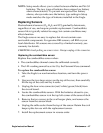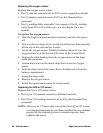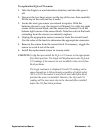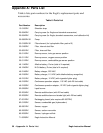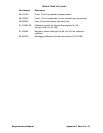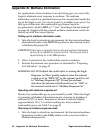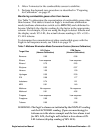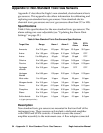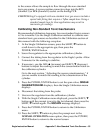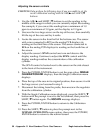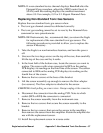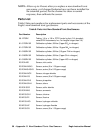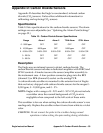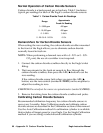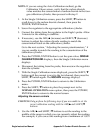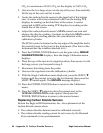Eagle Instruction Manual Appendix C: Non-Standard Toxic Gas Sensors • 55
to the sensor allows the sample to flow through the non-standard
toxic gas sensor. A seven-position connector plugs into the EC3
(channel 3) or EC4 (channel 4) socket on the analog PCB.
CAUTION:Eagle’s equipped with non-standard toxic gas sensors include a
special inlet fitting that requires a Teflon sample hose. Using a
standard sample hose for these applications may result in
inaccurate gas readings.
Calibrating Non-Standard Toxic Gas Sensors
Recommended calibration frequency for non-standard toxics sensors
is 3 to 6 months. Use the Single Calibration method to calibrate non-
standard toxic gas sensors as described in the Calibration section of
this manual with the following exception.
1. At the Single Calibration screen, press the SHIFT/▼ button to
scroll down to the appropriate gas, then press the
POWER/ENTER button.
2. Screw the regulator to the appropriate calibration cylinder.
3. Connect the tubing from the regulator to the Eagle’s probe. Allow
2 minutes for the reading to stabilize.
4. If necessary, use the AIR/▲ (increase) and SHIFT/▼ (decrease)
buttons to adjust the reading to match the concentration listed on
the calibration cylinder.
Go to the next section, “Adjusting the sensor potentiometers,” if
you are unable to match the reading to the concentration of the
cylinder.
5. Press the POWER/ENTER button to set the span value. SINGLE
CALIBRATION END displays, then the Single Calibration menu
displays.
6. Disconnect the tubing from the probe.
7. Unscrew the regulator from the calibration cylinder.
8. With the Single Calibration menu displayed, press the SHIFT/▼
button until the prompt is next to the last channel, then press the
SHIFT/▼ button again. The ESCAPE message displays.
9. Press the POWER/ENTER button to return to the Calibration
menu.
10. Press the SHIFT/▼ button to place the prompt next to the
NORMAL OPERATION menu option, then press the POWER/
ENTER button to return to the normal screen.



